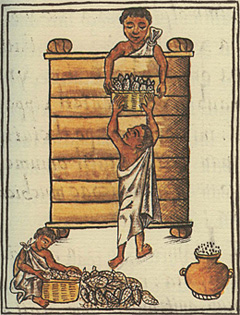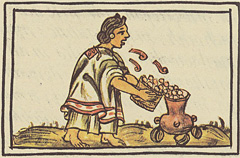
|
 |
 |
 Editorials | Environmental | June 2008 Editorials | Environmental | June 2008  
Early Origins of Maize in Mexico
 Dr. John Jones - American Society of Plant Biologists Dr. John Jones - American Society of Plant Biologists
go to original


| | Storing maize. Illustration from the Florentine Codex, Late 16th century. (Wikimedia) | 
| | Aztec woman blowing on maize (corn) before putting it into the cooking pot so it will not fear the fire. Florentine Codex, Late 16th century. (Wikimedia) | | |
Paleobotanical evidence pushes back the time of domestication

The ancestors of maize originally grew wild in Mexico and were radically different from the plant that is now one of the most important crops in the world. While the evidence is clear that maize was first domesticated in Mexico, the time and location of the earliest domestication and dispersal events are still in dispute. Now, in addition to more traditional macrobotanical and archeological remains, scientists are using new genetic and microbotanical techniques to distinguish domesticated maize from its wild relatives as well as to identify ancient sites of maize agriculture. These new analyses suggest that maize may have been domesticated in Mexico as early as 10,000 years ago.

Dr. John Jones and his colleagues, Mary Pohl, and Kevin Pope, have evaluated multiple lines of evidence, including paleobotanical remains such as pollen, phytoliths, and starch grains, as well as genetic analyses, to reconstruct the early history of maize agriculture. Dr. Jones, of the Department of Anthropology, Washington State University, Pullman, will be presenting this work at a symposium on Maize Biology at the annual meeting of the American Society of Plant Biologists in Mérida, Mexico (June 28, 8:30 AM).

While macrobotanical remains such as maize kernels, cobs, and leaves have been found in dry mountain caves, such remains are not preserved in more humid lowland areas, so the conclusions based on such remains are fragmentary. Much smaller parts of the maize plant, like cellular silica deposits, called phytoliths, and pollen and starch grains, are preserved under both humid and dry conditions. These lines of evidence, along with genetic and archeological data, are being used to reconstruct the history of agriculture to its origins around the world.

Maize is wind pollinated and sheds large amounts of pollen, which is deposited in soil and water sediments. The tough outer wall (exine) of pollen protects it from deterioration for thousands of years. While it is possible to distinguish the pollen grains of maize and its close relatives from other grasses, it is more difficult, except at the largest sizes, to differentiate the pollen of maize (Zea mays) from its presumed wild ancestor teosinte (Zea sp). Thus, while pollen can provide evidence of the presence of domesticated maize, along with that from other plants indicating agricultural activity, maize pollen alone is not definitive evidence of domesticated plants.

Phytoliths are another type of plant microfossil that is preserved for thousands of years and can be used to distinguish domesticated from wild maize. These microscopic bodies are silica or calcium oxalate deposits that accumulate in the intercellular spaces of plant stems, leaves, and roots and have characteristic shapes depending on genus and species. They are preserved even when the plant is burned or disintegrated. Scientists have found that it is possible to distinguish the microliths of teosinte from those of maize and other grasses, thus allowing them to identify the approximate dates and locations of early agricultural activity. Phytoliths are also preserved on ceramic and stone artifacts used to process food.

Jones and his co-workers analyzed the sediments from San Andrés, in the state of Tabasco on the Mexican Gulf Coast. Analysis of area sediments revealed phytoliths of domesticated varieties of maize as well as those of agricultural weeds. These data, along with evidence of burning, suggested that agriculturalists were active in that part of the Yucatan Peninsula around 7,000 years ago.

Starch grains are the most recent addition to the archeobotanical toolbox. Maize and its grass relatives produce large quantities of starch grains with unique morphological characteristics and, like phytoliths, are preserved in sediments and on cultural artifacts. Maize produces more starch than its wild relative teosinte, and the grains are much larger. The paleobotanist Dolores Piperno and her colleagues have established a number of criteria for distinguishing the starch grains of different grasses and found that those of maize and teosinte could be reliably separated on the basis of size and other morphological characters.

Maize also has a rich genetic history, which has resulted in thousands of varieties or landraces adapted to different environmental conditions. Maize scientists and geneticists have used this information to track the evolution and dispersal of maize varieties as well as to reconstruct the history of maize domestication. For example, the locus teosinte glume architecture 1 (tga1), is important in determining phytolith formation and morphology and, along with other "domestication genes" can be used to write the history of maize domestication and use by humans.

All of these methods are being used by paleobotanists, plant scientists, and archeologists like Jones and his colleagues, to reconstruct the rich history of maize domestication and evolution. Many of the ancient varieties were adaptations to different environmental conditions such as different soils, temperature, altitude, and drought. Preservation of these varieties and knowledge of their genetic and adaptive histories are of paramount importance as farmers around the world cope with changes in soil, temperature, and water availability and struggle to maintain a food supply for growing populations.

jonesjg(at)wsu.edu | 
 | |
 |



